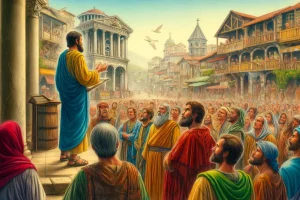
The Book of Habakkuk
The Book of Habakkuk is an intriguing prophetic text from the Old Testament, known for its unique structure and profound theological inquiries. Here are some quick facts about the Book of Habakkuk:
- Authorship: Habakkuk, the prophet, is credited as the author, although little is known about his life beyond what can be inferred from the text.
- Historical Context: Habakkuk likely prophesied in the late 7th century BCE, during the reign of Jehoiakim (609-598 BCE) and just before the Babylonian invasion of Judah.
- Structure: The book contains three chapters and is uniquely composed of a dialogue between Habakkuk and God, followed by a psalm in the final chapter.
- Chapters 1-2: Habakkuk’s dialogue with God, questioning the justice of God’s ways.
- Chapter 3: A prayer or psalm of Habakkuk, which is a poetic expression of trust in God despite adversity.
- Themes:
- The Problem of Evil: Habakkuk wrestles with understanding how a just God can seemingly tolerate injustice.
- Divine Justice: The book explores God’s justice and reaffirms His control over worldly affairs.
- Faith and Trust: Emphasizes the importance of living by faith, even in difficult circumstances.
- Key Passages:
- Habakkuk 2:4: “Behold, his soul is puffed up; it is not upright within him, but the righteous shall live by his faith.”
- Habakkuk 3:17-18: “Though the fig tree should not blossom, nor fruit be on the vines… yet I will rejoice in the LORD; I will take joy in the God of my salvation.”
- Literary Features: Habakkuk is notable for its poetic literature and the use of dialogues, making it distinct among the prophetic books. The vivid imagery and emotional intensity of the psalm in chapter 3 are particularly compelling.
- Theological Significance: Habakkuk addresses profound questions about faith, justice, and theodicy, making it a text of enduring relevance and depth.
The Book of Habakkuk stands out among the prophetic books of the Old Testament due to its introspective dialogue between the prophet and God. Unlike many prophetic texts that address the people directly, Habakkuk is primarily a conversation about divine justice and the problem of evil. Here’s a detailed analysis of this profound book:
1. Historical Context
Habakkuk likely prophesied during the late 7th century BCE, around the time of King Jehoiakim’s reign in Judah, just before the Babylonian assault under Nebuchadnezzar. This was a period marked by political upheaval and the impending threat of Babylonian invasion, which sets the backdrop for Habakkuk’s inquiries into the nature of divine justice.
2. Structure
The Book of Habakkuk is composed of three chapters:
- Chapter 1 opens with Habakkuk’s lament, questioning why God allows wickedness and injustice to prevail in Judah. This is followed by God’s response, explaining that He will use the Babylonians, a people even more corrupt than the Judeans, as instruments of judgment.
- Chapter 2 continues with Habakkuk’s second complaint, questioning how God can use a nation more wicked than Judah to punish His own people. God reassures him that the Babylonian aggressors will also be held accountable for their sins, emphasizing that “the righteous shall live by his faith.”
- Chapter 3 shifts from dialogue to a prayer or psalm of faith, reflecting Habakkuk’s ultimate acceptance of God’s sovereign will and his trust in God’s salvation, despite impending calamities.
3. Major Themes
- The Problem of Evil: At its core, Habakkuk addresses the philosophical and theological issue of why a just God permits evil. The dialogue format allows these profound questions to be explored in depth.
- Divine Justice: The text explores the nuances of divine justice, asserting that God’s ways, though mysterious, are always just. It assures that evil and injustice are temporary, and perpetrators will ultimately face divine retribution.
- Faith Amidst Suffering: A central message is the triumph of faith over doubt. Habakkuk concludes that faith in God’s goodness and justice must prevail over despair, symbolized in the majestic prayer of chapter 3.
4. Literary Features
Habakkuk utilizes a mixture of genres, including complaint, dialogue, oracle, and prayer. This diversity adds a rich texture to the book and enhances its theological and emotional depth. The vivid descriptions and passionate expressions in Habakkuk’s prayer are particularly notable for their poetic power.
5. Theological Significance
Habakkuk’s discussion with God provides profound insights into the nature of faith, especially the idea that true faith must often endure through periods of doubt and confusion. The statement “the righteous shall live by his faith” is a pivotal concept in Christian theology, influencing New Testament writers.
6. Contemporary Relevance
Habakkuk’s themes of wrestling with doubt and clinging to faith in troubling times continue to resonate with modern readers. It offers a framework for understanding and persevering through personal and communal trials.
In summary, the Book of Habakkuk offers a unique and introspective look at the struggle with and resolution of profound theological questions regarding evil, justice, and faith. Its message encourages believers to maintain faith in God’s overarching plans for justice and redemption, even when those plans are difficult to understand.



